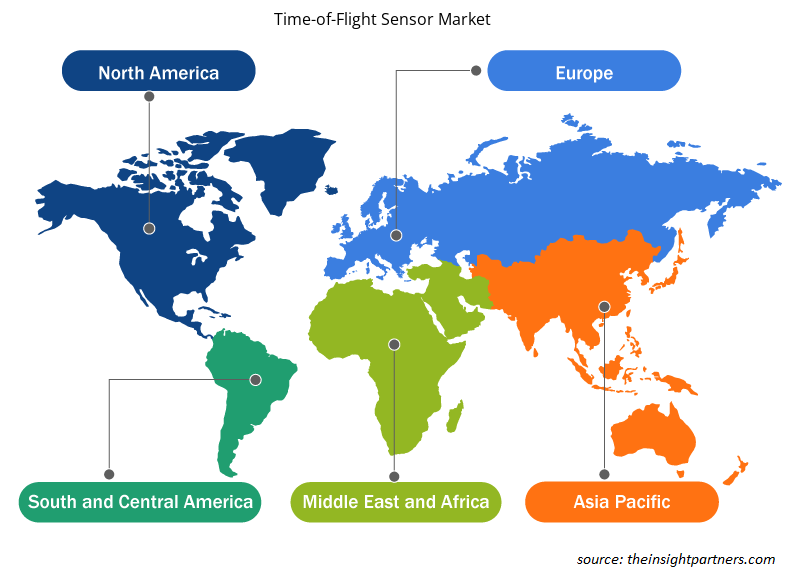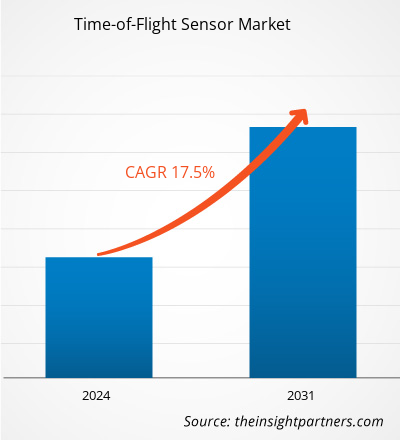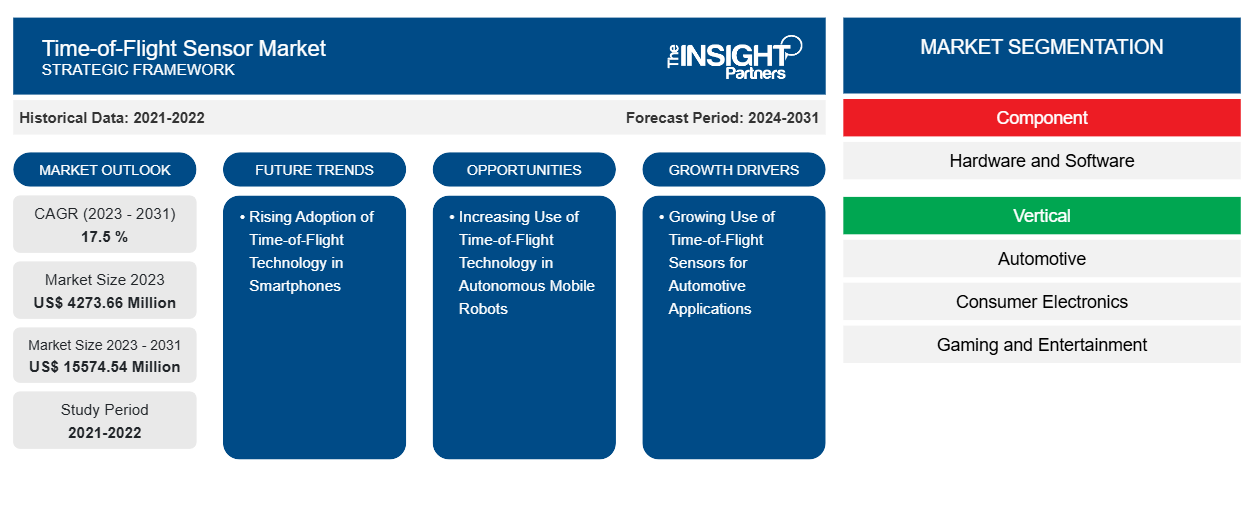Le marché des capteurs de temps de vol devrait atteindre 15 574,54 millions USD d’ici 2031, contre 4 273,66 millions USD en 2023. Le marché devrait enregistrer un TCAC de 17,5 % au cours de la période 2023-2031. L’adoption croissante de la technologie du temps de vol dans les smartphones devrait rester une tendance clé du marché.
Analyse du marché des capteurs de temps de vol
La demande de capteurs ToF augmente en raison de leur utilisation croissante dans l'industrie automobile. Cette technologie est utilisée pour surveiller le comportement du conducteur, ce qui permet de prévenir les accidents de la route et d'améliorer la sécurité des véhicules. En outre, la demande de capteurs augmente dans d'autres secteurs, tels que l'électronique grand public, la santé, les jeux et le divertissement, l'aérospatiale et la défense. En conséquence, les acteurs du marché proposent des capteurs ToF avancés. En février 2020, Panasonic Corporation a annoncé avoir développé un capteur d'image à temps de vol qui utilise des pixels à photodiode à avalanche (APD). Il peut acquérir des informations 3D très précises en fonction de la position des objets à des distances proches ou lointaines jusqu'à 250 m. Ces capteurs peuvent être appliqués dans divers domaines, tels que l'imagerie automobile et la surveillance à grande échelle.
Aperçu du marché des capteurs de temps de vol
Les capteurs de temps de vol (ToF) sont utilisés pour mesurer le temps mis par un objet pour parcourir une distance à travers un milieu. Il calcule la différence de temps entre l'émission d'un signal et son retour au capteur après avoir été réfléchi par un objet. Le capteur est utilisé pour diverses applications, notamment la navigation de robots, le comptage de personnes, la surveillance de véhicules et la détection d'objets. Il s'agit d'un système tout-en-un pour une intégration économique, facile et peu encombrante. Il fournit une véritable mesure de distance sans dépendre de la taille, de la couleur et de la réflectance de la cible. De plus, les capteurs ToF utilisent des lasers pour mesurer de longues distances et une portée avec une grande précision.
Personnalisez ce rapport en fonction de vos besoins
Vous bénéficierez d'une personnalisation gratuite de n'importe quel rapport, y compris de certaines parties de ce rapport, d'une analyse au niveau des pays, d'un pack de données Excel, ainsi que de superbes offres et réductions pour les start-ups et les universités.
-
Obtenez les principales tendances clés du marché de ce rapport.Cet échantillon GRATUIT comprendra une analyse de données, allant des tendances du marché aux estimations et prévisions.
Facteurs moteurs et opportunités du marché des capteurs de temps de vol
Utilisation croissante des capteurs de temps de vol pour les applications automobiles
Parallèlement aux progrès réalisés en matière de sécurité automobile, la technologie ToF offre un confort et une commodité à l'intérieur de l'habitacle, ce qui peut profiter aux conducteurs et aux passagers. Les sièges peuvent être déplacés et les ceintures de sécurité peuvent être rapprochées lorsque le passager monte dans la voiture. Elle peut également aider le conducteur ou le passager en allumant la lumière des compartiments de rangement lorsqu'une main se tend dans cette direction. Ainsi, l'utilisation croissante des capteurs ToF pour les applications automobiles stimule la croissance du marché des capteurs de temps de vol.
Utilisation croissante de la technologie du temps de vol dans les robots mobiles autonomes
Dans les opérations d'entrepôt, les caméras à temps de vol peuvent fournir une intelligence supérieure aux robots mobiles autonomes (AMR) et aux véhicules à guidage automatique (AGV). Les caméras peuvent être utilisées pour observer l'environnement et capturer des données d'imagerie en profondeur, ce qui améliore encore les fonctions critiques de l'entreprise avec précision, commodité et rapidité. La caméra a diverses fonctions telles que la localisation, la cartographie, l'évitement d'obstacles, la navigation, la détection d'objets et l'odométrie. La demande de caméras à temps de vol augmente, ce qui permet aux acteurs du marché d'obtenir des caméras à temps de vol technologiquement avancées. Ainsi, de telles innovations par les acteurs du marché et l'adoption croissante de capteurs à temps de vol dans les AMR créent des opportunités lucratives pour le marché des capteurs à temps de vol.
Analyse de segmentation du rapport sur le marché des capteurs de temps de vol
Les segments clés qui ont contribué à l’élaboration de l’analyse du marché des capteurs de temps de vol sont le type d’appareil et le secteur vertical.
- En fonction du type d'appareil, le marché des capteurs à temps de vol est divisé en sources lumineuses modulées RF avec détecteurs de phase, imageurs à porte de distance et imageurs à temps de vol direct. Le segment des logiciels détenait une part de marché plus importante en 2023.
- Par secteur vertical, le marché est segmenté en automobile, électronique grand public, jeux et divertissement, industrie, santé, aérospatiale et défense, entre autres.
Analyse des parts de marché des capteurs de temps de vol par géographie
La portée géographique du rapport sur le marché des capteurs de temps de vol est principalement divisée en cinq régions : Amérique du Nord, Asie-Pacifique, Europe, Moyen-Orient et Afrique, et Amérique du Sud et centrale. Le marché nord-américain est attribué à la demande croissante de capteurs de temps de vol (ToF) dans les applications automobiles et électroniques grand public. Certaines des fonctions de sécurité offertes par la caméra ToF sont la détection de fatigue du conducteur mandatée par NCAP, la posture du corps, le regard, la détection des mains sur le volant, l'application avancée de la ceinture de sécurité et la posture de la tête. La fonction de sécurité du capteur de temps de vol est bénéfique pour les accidents de la route. En raison de la sensibilisation croissante aux fonctions de sécurité, la demande de véhicules intégrés à la caméra ToF augmente dans la région nord-américaine.
Aperçu régional du marché des capteurs de temps de vol
Les tendances régionales et les facteurs influençant le marché des capteurs de temps de vol tout au long de la période de prévision ont été expliqués en détail par les analystes d’Insight Partners. Cette section traite également des segments et de la géographie du marché des capteurs de temps de vol en Amérique du Nord, en Europe, en Asie-Pacifique, au Moyen-Orient et en Afrique, ainsi qu’en Amérique du Sud et en Amérique centrale.

- Obtenez les données régionales spécifiques au marché des capteurs de temps de vol
Portée du rapport sur le marché des capteurs de temps de vol
| Attribut de rapport | Détails |
|---|---|
| Taille du marché en 2023 | 4 273,66 millions de dollars américains |
| Taille du marché d'ici 2031 | 15 574,54 millions de dollars américains |
| Taux de croissance annuel composé mondial (2023-2031) | 17,5 % |
| Données historiques | 2021-2022 |
| Période de prévision | 2024-2031 |
| Segments couverts |
Par composant
|
| Régions et pays couverts |
Amérique du Nord
|
| Leaders du marché et profils d'entreprises clés |
|
Densité des acteurs du marché des capteurs de temps de vol : comprendre son impact sur la dynamique des entreprises
Le marché des capteurs de temps de vol connaît une croissance rapide, tirée par la demande croissante des utilisateurs finaux en raison de facteurs tels que l'évolution des préférences des consommateurs, les avancées technologiques et une plus grande sensibilisation aux avantages du produit. À mesure que la demande augmente, les entreprises élargissent leurs offres, innovent pour répondre aux besoins des consommateurs et capitalisent sur les tendances émergentes, ce qui alimente davantage la croissance du marché.
La densité des acteurs du marché fait référence à la répartition des entreprises ou des sociétés opérant sur un marché ou un secteur particulier. Elle indique le nombre de concurrents (acteurs du marché) présents sur un marché donné par rapport à sa taille ou à sa valeur marchande totale.
Les principales entreprises opérant sur le marché des capteurs de temps de vol sont :
- Société OMRON
- STMicroelectronics NV
- Keyence Corp
- Teledyne e2v (Outre-mer)
- Holdings Ltée
- Texas Instruments Inc
Avis de non-responsabilité : les sociétés répertoriées ci-dessus ne sont pas classées dans un ordre particulier.

- Obtenez un aperçu des principaux acteurs du marché des capteurs de temps de vol
Actualités et développements récents du marché des capteurs de temps de vol
Le marché des capteurs de temps de vol est évalué en collectant des données qualitatives et quantitatives après des recherches primaires et secondaires, qui comprennent d'importantes publications d'entreprise, des données d'association et des bases de données. Quelques-uns des développements sur le marché des capteurs de temps de vol sont répertoriés ci-dessous :
- STMicroelectronics a présenté de nouveaux capteurs à temps de vol haute résolution pour l'imagerie de profondeur 3D avancée destinée aux smartphones et autres appareils. Le capteur VD55H1 cartographie les surfaces 3D en mesurant la distance à environ un demi-million de points et permet de détecter des objets jusqu'à 5 m du capteur. (Source : STMicroelectronics, communiqué de presse, mars 2022.)
- TDK Corporation a lancé les Chirp ICU-10201 et ICU-20201, des capteurs à ultrasons à temps de vol intégrés à très faible consommation et à hautes performances pour la détection à longue et courte portée. La société indique que les nouveaux capteurs MEMS offrent des mesures de portée précises jusqu'à une distance de 5 m sur un champ de vision large et configurable. (Source : TDK Corporation, communiqué de presse, janvier 2022)
Rapport sur le marché des capteurs de temps de vol et livrables
Le rapport « Taille et prévisions du marché des capteurs de temps de vol (2021-2031) » fournit une analyse détaillée du marché couvrant les domaines ci-dessous :
- Taille et prévisions du marché des capteurs de temps de vol aux niveaux mondial, régional et national pour tous les segments de marché clés couverts par le champ d'application
- Tendances du marché des capteurs de temps de vol ainsi que dynamique du marché telles que les facteurs moteurs, les contraintes et les opportunités clés
- Analyse détaillée des cinq forces de PEST/Porter et SWOT
- analyse du marché des capteurs de temps de vol couvrant les principales tendances du marché, le cadre mondial et régional, les principaux acteurs, les réglementations et les développements récents du marché
- Analyse du paysage industriel et de la concurrence couvrant la concentration du marché, l'analyse de la carte thermique, les principaux acteurs et les développements récents pour le marché des capteurs de temps de vol
- Profils d'entreprise détaillés
- Analyse historique (2 ans), année de base, prévision (7 ans) avec TCAC
- Analyse PEST et SWOT
- Taille du marché Valeur / Volume - Mondial, Régional, Pays
- Industrie et paysage concurrentiel
- Ensemble de données Excel
Rapports récents
Rapports connexes
Témoignages
Raison d'acheter
- Prise de décision éclairée
- Compréhension de la dynamique du marché
- Analyse concurrentielle
- Connaissances clients
- Prévisions de marché
- Atténuation des risques
- Planification stratégique
- Justification des investissements
- Identification des marchés émergents
- Amélioration des stratégies marketing
- Amélioration de l'efficacité opérationnelle
- Alignement sur les tendances réglementaires























 Obtenez un échantillon gratuit pour - Marché des capteurs de temps de vol
Obtenez un échantillon gratuit pour - Marché des capteurs de temps de vol